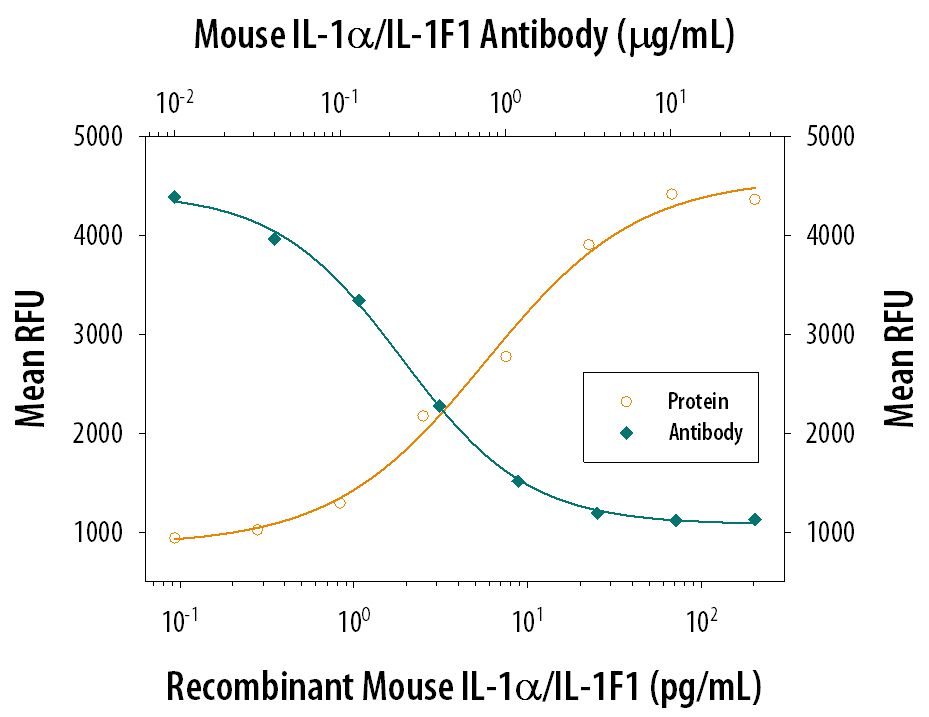Mouse IL-1 alpha /IL-1F1 Antibody Summary
IL‑1 alpha /IL‑1F1, and recombinant human IL‑1 alpha /IL‑1F1 is observed.
Ser115-Ser270
Accession # P01582
Applications
Mouse IL-1 alpha /IL-1F1 Sandwich Immunoassay
Please Note: Optimal dilutions should be determined by each laboratory for each application. General Protocols are available in the Technical Information section on our website.
Scientific Data
 View Larger
View Larger
Cell Proliferation Induced by IL‑1 alpha /IL‑1F1 and Neutralization by Mouse IL‑1 alpha /IL‑1F1 Antibody. Recombinant Mouse IL-1a/IL-1F1 (Catalog # 400-ML) stimulates proliferation in the the D10.G4.1 mouse helper T cell line in a dose-dependent manner (orange line). Proliferation elicited by Recombinant Mouse IL-1a/IL-1F1 (50 pg/mL) is neutralized (green line) by increasing concentrations of Rat Anti-Mouse IL-1a/IL-1F1 Monoclonal Antibody (Catalog # MAB400). The ND50 is typically 0.2-0.6 µg/mL.
Reconstitution Calculator
Preparation and Storage
- 12 months from date of receipt, -20 to -70 °C as supplied.
- 1 month, 2 to 8 °C under sterile conditions after reconstitution.
- 6 months, -20 to -70 °C under sterile conditions after reconstitution.
Background: IL-1 alpha/IL-1F1
IL-1 is a name that designates two proteins, IL-1 alpha and IL-1 beta, that are the products of distinct genes, but recognize the same cell surface receptors. IL-1 alpha and IL-1 beta are structurally related polypeptides that show approximately 25% homology at the amino acid level. Both proteins are produced by a wide variety of cells in response to stimuli such as those produced by inflammatory agents, infections, or microbial endotoxins. The proteins are synthesized as 31 kDa precursors that are subsequently cleaved into proteins with molecular weights of approximately 17.5 kDa. The specific protease responsible for the processing of IL-beta, designated interleukin 1 beta ‑converting enzyme (ICE), has been described. Mature human and mouse IL-1 beta share approximately 75% amino acid sequence identity and human IL-1 beta has been found to be active on murine cell lines.
IL-1 alpha and IL-1 beta are potent pro-inflammatory cytokines that induce a wide variety of biological activities on different cell types. Two distinct types of IL-1 receptors have been identified and cloned from human and mouse cells. The IL-1 receptor type I is a 80 kDa transmembrane protein with demonstrated IL-1 signaling function. The IL-1 receptor type II is a 68 kDa membrane protein with a relatively short cytoplasmic tail and has no signaling function. The type II receptor acts as a decoy target for IL-1, inhibiting IL-1 activities by preventing the binding of IL-1 to the type I receptor. A soluble version of the type II receptor is induced by anti‑inflammatory agents such as glucocorticoids, IL-4, and IL-13.
Product Datasheets
Citations for Mouse IL-1 alpha /IL-1F1 Antibody
R&D Systems personnel manually curate a database that contains references using R&D Systems products. The data collected includes not only links to publications in PubMed, but also provides information about sample types, species, and experimental conditions.
8
Citations: Showing 1 - 8
Filter your results:
Filter by:
-
A20 prevents inflammasome-dependent arthritis by inhibiting macrophage necroptosis through its ZnF7 ubiquitin-binding domain
Authors: A Polykratis, A Martens, RO Eren, Y Shirasaki, M Yamagishi, Y Yamaguchi, S Uemura, M Miura, B Holzmann, G Kollias, M Armaka, G van Loo, M Pasparakis
Nat. Cell Biol., 2019-05-13;0(0):.
Species: Mouse
Sample Types: Cell Culture Supernates
Applications: Bioassay -
Alternatively activated macrophages determine repair of the infarcted adult murine heart
J Clin Invest, 2016-05-03;0(0):.
Species: Mouse
Sample Types: Whole Cells
Applications: Neutralization -
Myostatin is a direct regulator of osteoclast differentiation and its inhibition reduces inflammatory joint destruction in mice.
Authors: Dankbar B, Fennen M, Brunert D, Hayer S, Frank S, Wehmeyer C, Beckmann D, Paruzel P, Bertrand J, Redlich K, Koers-Wunrau C, Stratis A, Korb-Pap A, Pap T
Nat Med, 2015-08-03;21(9):1085-90.
Species: Mouse
Sample Types: Whole Cells
Applications: Neutralization -
Combination of inflammation-related cytokines promotes long-term muscle stem cell expansion.
Authors: Fu X, Xiao J, Wei Y, Li S, Liu Y, Yin J, Sun K, Sun H, Wang H, Zhang Z, Zhang B, Sheng C, Wang H, Hu P
Cell Res, 2015-05-15;25(6):655-73.
Species: Mouse
Sample Types: Protein
Applications: ELISA Development (Capture) -
Periostin controls keratinocyte proliferation and differentiation by interacting with the paracrine IL-1alpha/IL-6 loop.
Authors: Taniguchi K, Arima K, Masuoka M, Ohta S, Shiraishi H, Ontsuka K, Suzuki S, Inamitsu M, Yamamoto K, Simmons O, Toda S, Conway S, Hamasaki Y, Izuhara K
J Invest Dermatol, 2013-11-25;134(5):1295-304.
Species: Mouse
Sample Types: Whole Cells
Applications: Neutralization -
Resistance of human alveolar macrophages to Bacillus anthracis lethal toxin.
Authors: Wu W, Mehta H, Chakrabarty K, Booth JL, Duggan ES, Patel KB, Ballard JD, Coggeshall KM, Metcalf JP
J. Immunol., 2009-10-07;183(9):5799-806.
Species: Mouse
Sample Types: Cell Culture Supernates
Applications: ELISA Development -
Increased cytokine production in IL-18 receptor alpha-deficient cells is associated with dysregulation of suppressors of cytokine signaling (SOCS).
Authors: Nold-Petry CA, Nold MF, Nielsen JW, Bustamante A, Zepp JA, Storm KA, Hong JW, Kim SH, Dinarello CA
J. Biol. Chem., 2009-07-10;0(0):.
Species: Mouse
Sample Types: Cell Culture Supernates
Applications: ELISA Development -
Viral infection of the lungs through the eye.
Authors: Bitko V, Musiyenko A, Barik S
J. Virol., 2006-10-18;81(2):783-90.
Species: Mouse
Sample Types: In Vivo
Applications: Neutralization
FAQs
No product specific FAQs exist for this product, however you may
View all Antibody FAQsReviews for Mouse IL-1 alpha /IL-1F1 Antibody
There are currently no reviews for this product. Be the first to review Mouse IL-1 alpha /IL-1F1 Antibody and earn rewards!
Have you used Mouse IL-1 alpha /IL-1F1 Antibody?
Submit a review and receive an Amazon gift card.
$25/€18/£15/$25CAN/¥75 Yuan/¥2500 Yen for a review with an image
$10/€7/£6/$10 CAD/¥70 Yuan/¥1110 Yen for a review without an image


